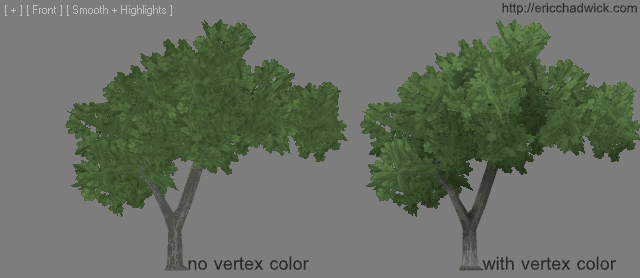Difference between revisions of "Foliage Vertex Color"
From polycount
m (edit layout) |
EricChadwick (Talk | contribs) (Foliage) |
||
| Line 1: | Line 1: | ||
| − | [[Vertex color]] can be used to add fake lighting to flat | + | [[Vertex color]] can be used to add fake lighting to flat [[Foliage]] meshes to create the illusion of a softly-lit foliage volume. |
Foliage meshes in game are usually made using flat planes with a [[TransparencyMap|transparent]] texture containing a bunch of leaves (or grass blades). These textures are used instead of modeling each leaf or blade of grass discretely, because the complex geometry renders slowly and also greatly increases the memory cost for the model. | Foliage meshes in game are usually made using flat planes with a [[TransparencyMap|transparent]] texture containing a bunch of leaves (or grass blades). These textures are used instead of modeling each leaf or blade of grass discretely, because the complex geometry renders slowly and also greatly increases the memory cost for the model. | ||
Latest revision as of 11:51, 12 August 2015
Vertex color can be used to add fake lighting to flat Foliage meshes to create the illusion of a softly-lit foliage volume.
Foliage meshes in game are usually made using flat planes with a transparent texture containing a bunch of leaves (or grass blades). These textures are used instead of modeling each leaf or blade of grass discretely, because the complex geometry renders slowly and also greatly increases the memory cost for the model.
But flat planes generally do not shade very well when lit, so foliage models are often rendered in-game without any lighting (see Emissive). If lighting is an option however, editing the vertex normals is one way to get better lighting.
